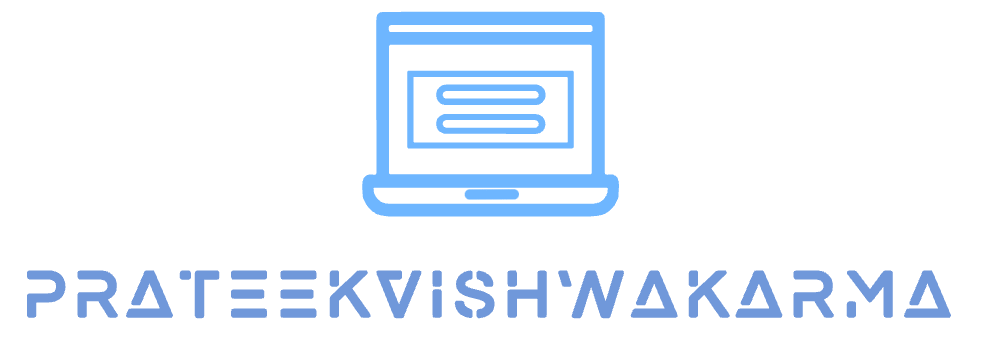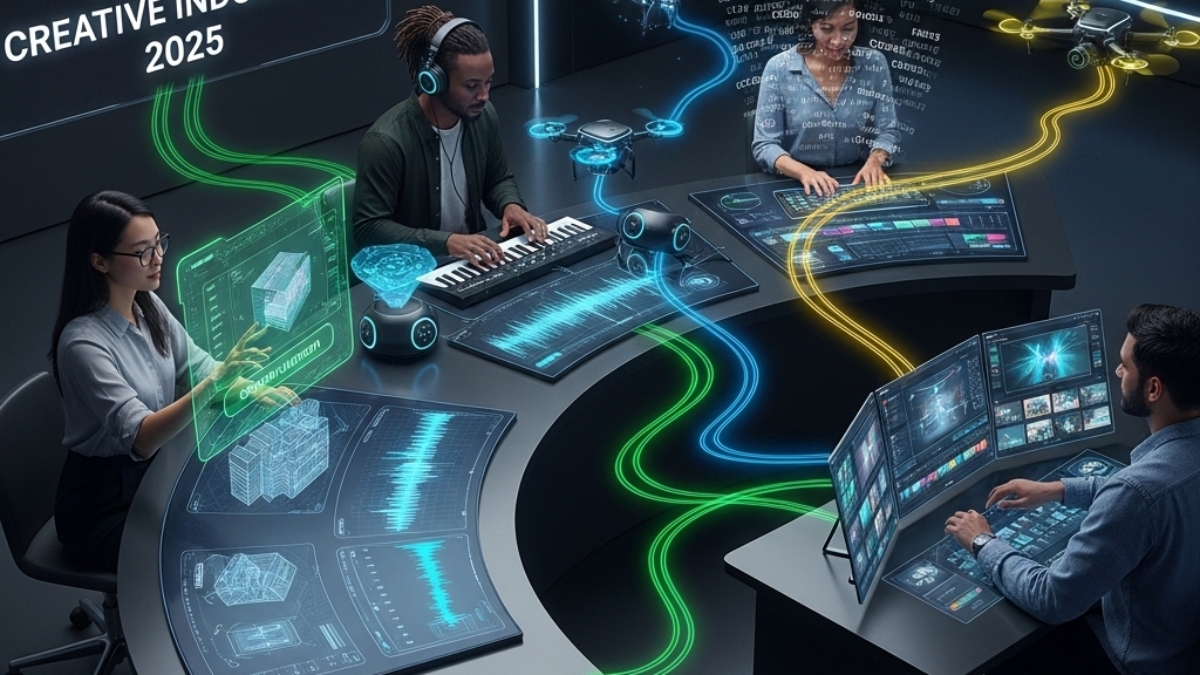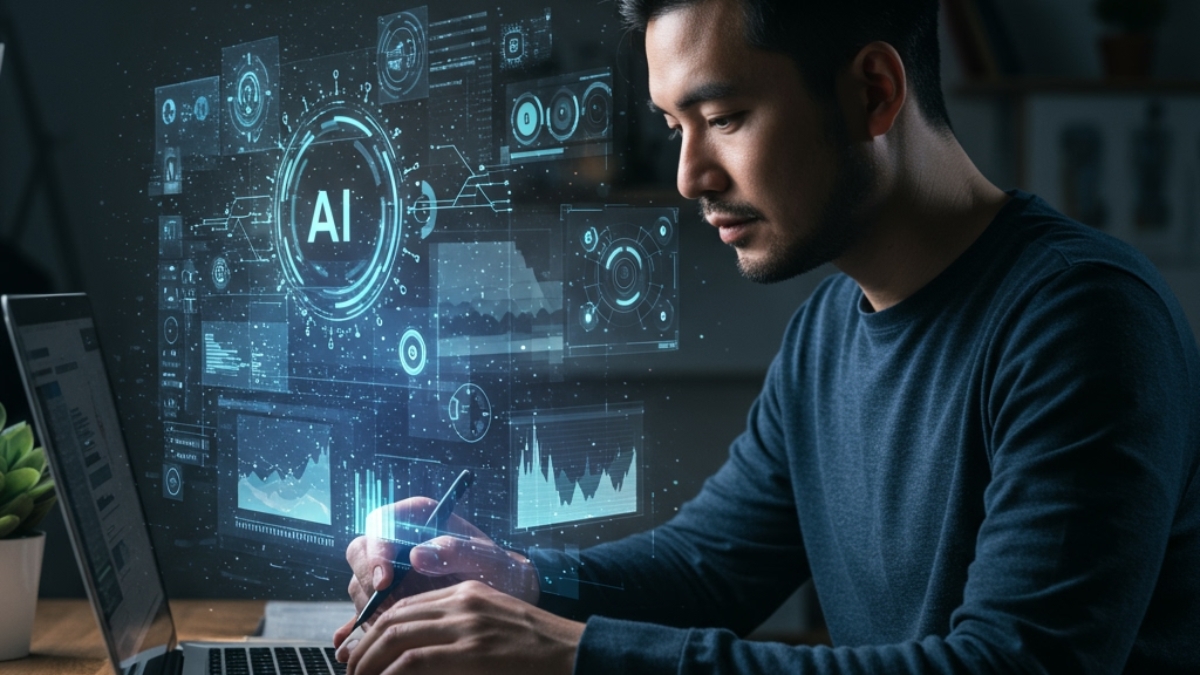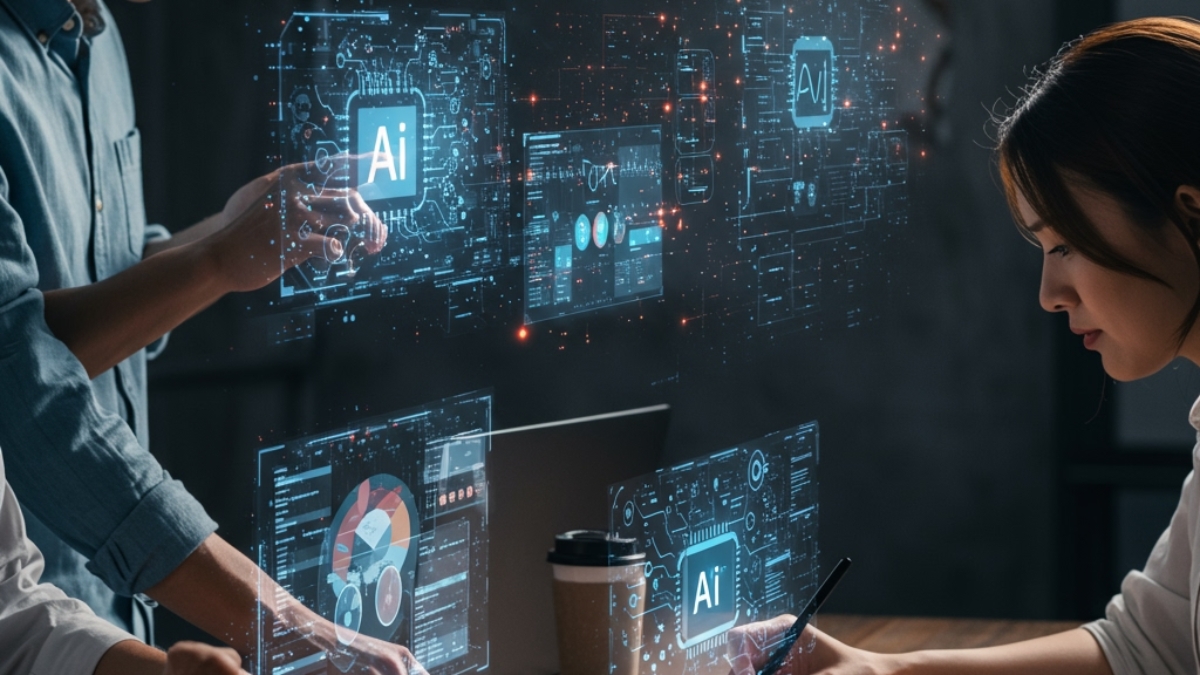Top AI Tools Revolutionizing Creative Industries in 2025
The Ultimate Creative Pro’s Playbook: Generative AI for Artists, Designers & More
The Ultimate Creative Pro’s Playbook: Generative AI for Artists, Designers & More
In a world rapidly reshaped by artificial intelligence, creative professionals stand at a pivotal moment. The rise of Generative AI isn’t merely a technological shift; it’s an invitation to redefine the boundaries of imagination, efficiency, and artistic expression. For discerning artists, designers, musicians, and storytellers, this isn’t about replacing human genius but augmenting it, unleashing unprecedented potential. This comprehensive playbook, designed for Generative AI for Creative Professionals, offers a practical, expert-driven guide to mastering the tools, techniques, and strategic foresight needed to thrive in this exciting new era.
Key Takeaways:
- Generative AI is a powerful augmentation tool, not a replacement, for creative professionals.
- Mastering prompt engineering and integrating AI into existing workflows are crucial skills.
- A diverse toolkit of AI applications exists for visual arts, audio, text, and video creation.
- Nuanced ethical frameworks, including copyright and attribution, must guide AI use.
- Future-proof your career by developing skills in AI art direction, ethical literacy, and interdisciplinary collaboration.
Understanding the Generative AI Revolution for Creatives
Generative AI systems, capable of producing novel content from text and other inputs, are transforming industries by learning patterns from vast datasets . For creatives, this technology transcends simple automation; it promises a powerful partnership, enabling faster ideation, more sophisticated iteration, and the ability to explore creative avenues previously unattainable . Think of it as an unparalleled assistant, freeing you from tedious tasks and providing endless creative springboards, allowing you to focus on the unique human touch: vision, emotion, and storytelling.
The core philosophy here is augmentation over automation. While some repetitive tasks in graphic design, such as basic image creation or resizing, can be automated, complex, nuanced, and original designs still demand human oversight and creative input. AI becomes a force multiplier, not a substitute, for the discerning professional.
The Essential Generative AI Toolkit for Creative Professionals
The market is rich with generative AI tools, each with unique strengths. Choosing the right one depends on your specific needs, skill level, and desired output. Here’s a curated selection:
AI for Visual Arts
- Midjourney & DALL-E 3: Widely recognized for high-quality image generation from text prompts. DALL-E 3 integrates seamlessly with ChatGPT, offering an intuitive experience, while Midjourney is known for its artistic and often dramatic outputs.
- Stable Diffusion: An open-source powerhouse, allowing extensive customization, fine-tuning, and the ability to train your own models for specific styles or subjects. Features like ControlNet offer precise control over image generation.
- Adobe Firefly: Integrated within Adobe’s Creative Cloud suite (Photoshop, Illustrator), Firefly offers generative fill, text-to-image, and vector graphics specifically designed for commercial use and trained on licensed content like Adobe Stock. This makes it a strong contender for professional workflows.
- Invoke AI: A platform built for creative production, offering studio-grade control, layer-based editing, and the ability to train and deploy specialized models (LoRA) for consistent branding or character design. It emphasizes IP protection and commercial use.
- Gencraft & OpenArt: User-friendly platforms offering various AI models, styles, and tools for image variations, editing, and even training custom models on your own images to maintain a unique style.
AI for Audio & Music
- ElevenLabs: Renowned for high-quality AI voice generation, capable of creating realistic speech and voiceovers for video, podcasts, or audiobooks.
- Suno & Soundraw: Tools for AI music generation, allowing creators to produce original tracks, scores, and soundscapes, simplifying the music composition process.
AI for Text & Ideation
- ChatGPT & Jasper: Excellent for brainstorming, generating marketing copy, social media captions, scripts, articles, and refining text tone. They can act as invaluable creative partners for initial content generation or overcoming writer’s block.
AI for Video & Motion
- Runway: Offers freeform and creative video generation and editing, enabling users to create, edit, and animate videos with powerful AI tools.
- Synthesia: Specializes in generating AI-powered videos, particularly useful for creating presentations, training materials, or marketing content with AI avatars and voiceovers.
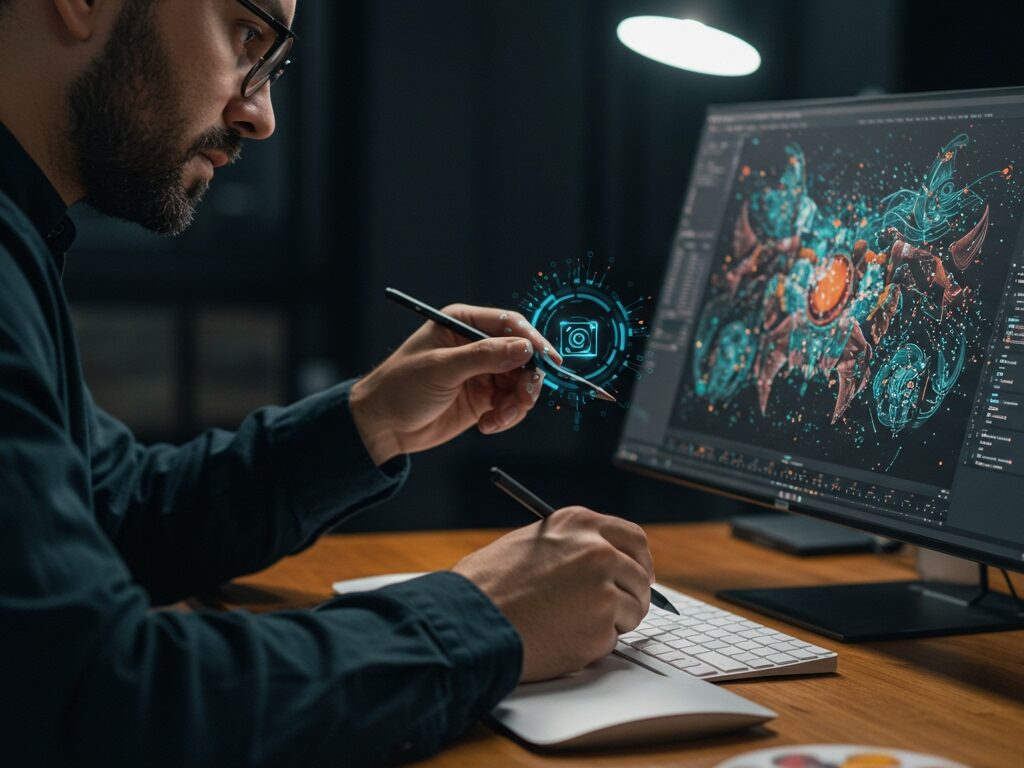
Mastering Generative AI: Actionable Techniques for Creative Professionals
Beyond simply knowing the tools, true mastery lies in understanding *how* to wield them effectively. This section delves into practical techniques for integrating generative AI into your unique creative process.
Prompt Engineering: Your New Creative Language
Prompt engineering is the art and science of communicating effectively with AI models to achieve desired outputs. It’s less about coding and more about clear, precise, and imaginative instruction.
- The Fundamentals: Clarity, Specificity, Context: Start with clear, concise instructions. Instead of “make a picture of a house,” try “a minimalist, modern house with large windows, surrounded by a serene, autumn forest, in the style of a digital painting, golden hour lighting.” Add context about the purpose or mood you want to evoke.
- Advanced Strategies: Iterative Refinement & Role Assignment: Don’t settle for the first output. Refine your prompts based on results, adding more detail or adjusting parameters like ‘temperature’ for randomness. Assign a ‘role’ to the AI (e.g., “You are a seasoned concept artist for a fantasy game,”) to guide its tone and style. Utilize advanced techniques like Chain-of-Thought (CoT) prompting, where you ask the AI to show its reasoning steps, or Tree-of-Thoughts (ToT) for exploring multiple reasoning paths, particularly useful for complex conceptual tasks.
Seamless Workflow Integration Examples
Integrating AI should feel like an extension of your existing process, not a disruption. Here’s how:
- Graphic Design & Illustration:
- Ideation & Rapid Prototyping: Use text-to-image AI to quickly generate hundreds of diverse concepts for logos, character designs, or mood boards. This speeds up the initial brainstorming phase significantly.
- Asset Generation: Create custom textures, patterns, brushes, or background elements that match your project’s style. Tools like Adobe Firefly can generate variations directly within Photoshop.
- Style Transfer & Enhancement: Apply a specific artistic style to your existing artwork or use AI for intelligent upscaling and detail refinement.
- Inpainting/Outpainting: Seamlessly remove unwanted objects or extend the canvas of your images with AI.
- Photography:
- Background Generation/Replacement: Instantly change backgrounds to match desired aesthetics or contexts.
- Object Removal/Addition: Clean up distracting elements or add realistic objects to scenes.
- Non-Destructive Editing: Use AI features for advanced retouching, color grading, or enhancing specific image areas, maintaining flexibility for adjustments.
- Video & Animation:
- Storyboarding & Concept Art: Generate visual storyboards from script excerpts or character concept art to quickly visualize scenes.
- Motion Graphics & VFX: Create dynamic titles, visual effects, or even generate short animated sequences from text prompts.
- Voiceovers & Soundtracks: Use AI for generating realistic voiceovers in multiple languages or composing bespoke soundtracks.
- Music & Sound Design:
- Melody & Harmony Generation: Produce unique musical phrases or explore different harmonic progressions.
- Soundscape Creation: Generate ambient sounds or specific sound effects for film, games, or immersive experiences.
- Mastering Assistance: AI tools can suggest optimal mixing and mastering settings, streamlining post-production.
Leveraging AI for Ideation, Iteration, and Refinement
Generative AI excels at overcoming creative blocks and accelerating the iterative process. Use it to:
- Brainstorm: Input a core idea and ask for variations, alternative interpretations, or entirely new directions.
- Iterate: Quickly generate multiple versions of a design element, allowing you to compare and refine with speed.
- Refine: Focus on specific areas for improvement, using AI to generate high-fidelity details or to experiment with micro-adjustments.
Brief: Training Custom AI Models for Your Unique Style
For advanced users and brands, platforms like Invoke AI, Stable Diffusion, OpenArt, and Gencraft offer the ability to train custom models (e.g., LoRAs) on your proprietary datasets or existing body of work. This allows the AI to learn and replicate your unique artistic style, specific characters, or brand guidelines with remarkable consistency, making it an invaluable tool for maintaining a distinct artistic voice at scale. Your intellectual property remains yours, with many platforms ensuring your custom models are exclusively in your control.
Navigating the Ethical Landscape: Best Practices for AI-Augmented Art
The ethical implications of generative AI are a critical consideration for every creative professional. Engaging with these tools responsibly requires understanding current legal discussions and adopting best practices.
Copyright, Ownership, and Intellectual Property
A key legal point is the concept of “human authorship.” The U.S. Copyright Office has consistently stated that works created *solely* by AI, without significant human creative input, are not eligible for copyright protection. This means if you simply type a prompt and an AI generates an image, that image generally falls into the public domain. However, if a human provides substantial creative input—such as editing, arranging, or selecting AI-generated elements, or refining prompts iteratively to achieve a specific artistic vision—those human-created portions *can* be copyrighted.
The debate intensifies around AI models trained on copyrighted material without artists’ explicit consent or compensation. As a creative, it’s crucial to:
- Review Terms of Service: Understand the IP policies of the AI platforms you use. Some, like Adobe Firefly, are trained on licensed content, making them safer for commercial use.
- Licensing AI-Generated Work: If your work involves a significant human creative element alongside AI, you can pursue copyright for your human contributions. Be transparent with clients about the AI’s role.
- Protecting Your Own Work: Be aware of how your art might be used for AI training. Advocate for opt-in systems for data collection and fair compensation.
Attribution and Transparency
Openness about AI’s role in your creative process builds trust. Clearly attribute when AI tools have been used, especially if the AI is a significant part of the creation. This not only sets ethical standards but also educates your audience on how you’re embracing new technologies.
Avoiding Bias and Promoting Inclusivity
AI models can inherit biases present in their training data, leading to outputs that perpetuate stereotypes or lack diversity. As a creative, be mindful of your prompts to counteract these biases. Actively seek to generate diverse and inclusive representations in your AI-assisted work, ensuring your art reflects a broad spectrum of experiences.
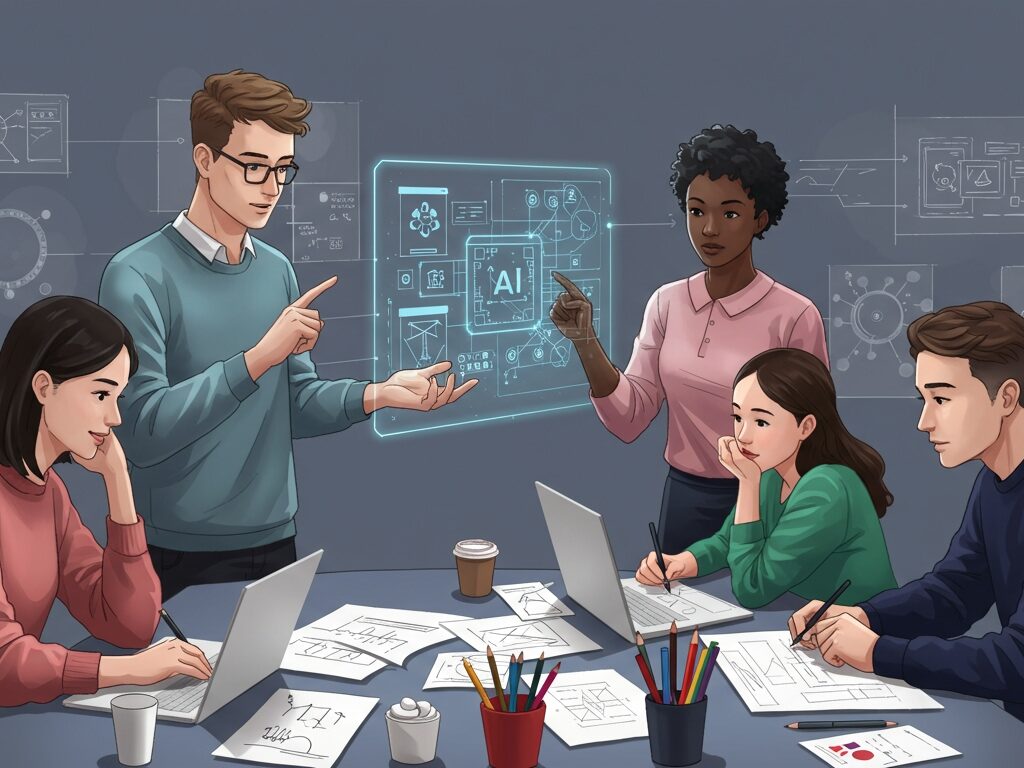
The Future-Proof Creative: Skills to Thrive in an AI World
The advent of generative AI reshapes the skillset required for success. Rather than fearing obsolescence, embrace these new competencies to elevate your career and unique artistic voice.
- Prompt Engineering Mastery: From Operator to AI Director: This is no longer a niche skill. Becoming adept at crafting precise, nuanced prompts to guide AI models is akin to mastering a new instrument. It’s about becoming an AI director, articulating a vision for the machine to execute.
- AI Art Direction & Curation: With AI generating vast quantities of content, the ability to discern, select, refine, and art direct AI outputs becomes paramount. This requires a keen aesthetic eye, a deep understanding of composition, color, and storytelling, and the ability to integrate AI-generated elements seamlessly into a cohesive whole.
- Ethical AI Use & Literacy: Understanding the legal, social, and ethical implications of AI-generated content is non-negotiable. This includes knowledge of copyright laws, attribution best practices, and the ability to identify and mitigate bias.
- Critical Thinking & Problem-Solving: AI is a tool; human critical thinking is still required to define problems, evaluate AI solutions, and make strategic creative decisions that resonate with human audiences.
- Interdisciplinary Collaboration: The future of creativity will increasingly involve collaborations between artists and technologists. Understanding basic AI concepts and being able to communicate across these disciplines will be a significant advantage.
- Data Curation & Model Training (Advanced): For those looking to push boundaries, the ability to curate custom datasets and train specialized AI models on their unique style or brand assets will unlock unparalleled creative control and competitive advantage.
Conclusion: Embracing AI as a Creative Partner
The landscape for Generative AI for Creative Professionals is not one of impending doom but of boundless opportunity. By embracing these powerful tools, mastering the techniques of prompt engineering and workflow integration, and navigating the ethical considerations with diligence, creatives can elevate their practice to new heights. The future of art isn’t an AI-generated future; it’s an AI-augmented one, where human creativity, vision, and emotion remain the irreplaceable heart of every masterpiece. Become the architect of your augmented artistic future.
Frequently Asked Questions (FAQ)
Q1: Can generative AI truly replace human artists?
No, generative AI is best understood as a powerful augmentation tool rather than a replacement for human artists. While AI can automate repetitive tasks and generate vast quantities of content, it lacks true human creativity, emotion, and the ability to understand nuanced client briefs, cultural context, or tell stories with authentic human insight. The most successful creatives will be those who learn to partner with AI, using it to enhance their unique artistic vision.
Q2: How do creative professionals ensure their AI-generated work is original and copyrightable?
To ensure originality and potential copyrightability, creative professionals must infuse substantial human creative input into their AI-assisted work. This means going beyond simple text prompts to actively edit, arrange, select, and refine AI outputs, making significant artistic choices. Works created *solely* by AI are generally not copyrightable under current U.S. law. Always review the terms of service of the AI platforms you use and be transparent about AI’s role. The U.S. Copyright Office provides guidance on AI and copyright.
Q3: What is prompt engineering, and why is it important for creatives?
Prompt engineering is the skill of crafting precise and effective textual instructions (prompts) to guide generative AI models in producing desired outputs. It’s crucial for creatives because it allows them to accurately communicate their artistic vision to the AI, moving beyond generic results to achieve highly specific styles, compositions, and creative goals. Mastering this skill transforms you from a casual user into an AI director, unlocking the full potential of these powerful tools.
Q4: How can AI tools be integrated into existing creative software like Adobe Photoshop or Illustrator?
Many generative AI tools, such as Adobe Firefly, are now directly integrated into popular creative software, offering features like generative fill, text-to-image, and style transfer within your familiar workspace. For other tools, integration often involves using APIs, plugins, or simply using AI to generate initial concepts or assets which are then imported and refined in your preferred design software. This approach streamlines workflows, automates tedious tasks, and provides creative assistance without disrupting your core process.
Q5: What ethical considerations should creatives be aware of when using generative AI?
Key ethical considerations include copyright infringement (especially concerning AI training data), proper attribution, potential for bias in AI outputs, and transparency with clients and audiences. Creatives should strive to use AI tools that respect intellectual property rights, always disclose AI’s role when appropriate, and actively work to mitigate biases in their generated content to promote inclusivity. Engaging with ethical frameworks is vital for responsible and respected practice in the AI era.
TAGS – AI art tools, generative AI techniques, AI in creative workflow, prompt engineering for artists, ethical AI art, future creative skills AI, AI tools for graphic design, AI for illustrators, AI for photographers, custom AI models creative.
Prompt Engineering for Non-Coders: Master AI Communication for Creative Professionals
The world of artificial intelligence is no longer exclusive to programmers. Creative professionals, from artists and writers to designers and musicians, are discovering the immense power of generative AI tools. These innovations are reshaping how ideas are born and brought to life. However, unlocking their full potential requires more than just typing a few words.
This is where prompt engineering comes in. It’s the art and science of crafting effective instructions that guide AI models to produce desired outputs. For non-coders, mastering this skill is about learning to speak the AI’s language. It’s about transforming vague ideas into precise commands, ensuring the AI understands your creative vision.
This guide will demystify prompt engineering, offering practical strategies and techniques for creative professionals. You don’t need to write a single line of code to become a proficient AI communicator.
Key Takeaways:
- Prompt engineering is crucial for guiding AI, even for non-coders.
- Clarity, context, and iterative refinement are core to effective prompting.
- Specific techniques exist for visual art, writing, and design.
- Popular no-code AI tools enable seamless creative workflows.
- Ethical considerations and avoiding common pitfalls are vital for responsible AI use.
Understanding Prompt Engineering: Beyond Code
What is Prompt Engineering?
Simply put, prompt engineering is the process of designing and refining inputs (prompts) for AI models to achieve optimal and desired results. Think of it as giving precise directions to a highly intelligent, but literal, assistant. The better your directions, the better the outcome.
It’s not about coding or complex algorithms. Instead, it focuses on natural language. You use words, phrases, and structures to communicate your intent. This approach makes it incredibly accessible to anyone, regardless of their technical background.
Why It’s Essential for Creatives
For creative professionals, AI is a powerful co-pilot. It can generate concept art, draft marketing copy, brainstorm story arcs, or even create musical compositions. Without effective prompting, however, your AI results might be generic, irrelevant, or simply not what you envisioned.
Mastering prompt engineering means:
- Accelerated Ideation: Quickly generate diverse concepts.
- Enhanced Quality: Produce outputs closer to your artistic vision.
- Increased Efficiency: Automate repetitive tasks and focus on high-level creativity.
- Unlocking New Possibilities: Explore creative avenues previously impossible.
The Art of Effective AI Communication
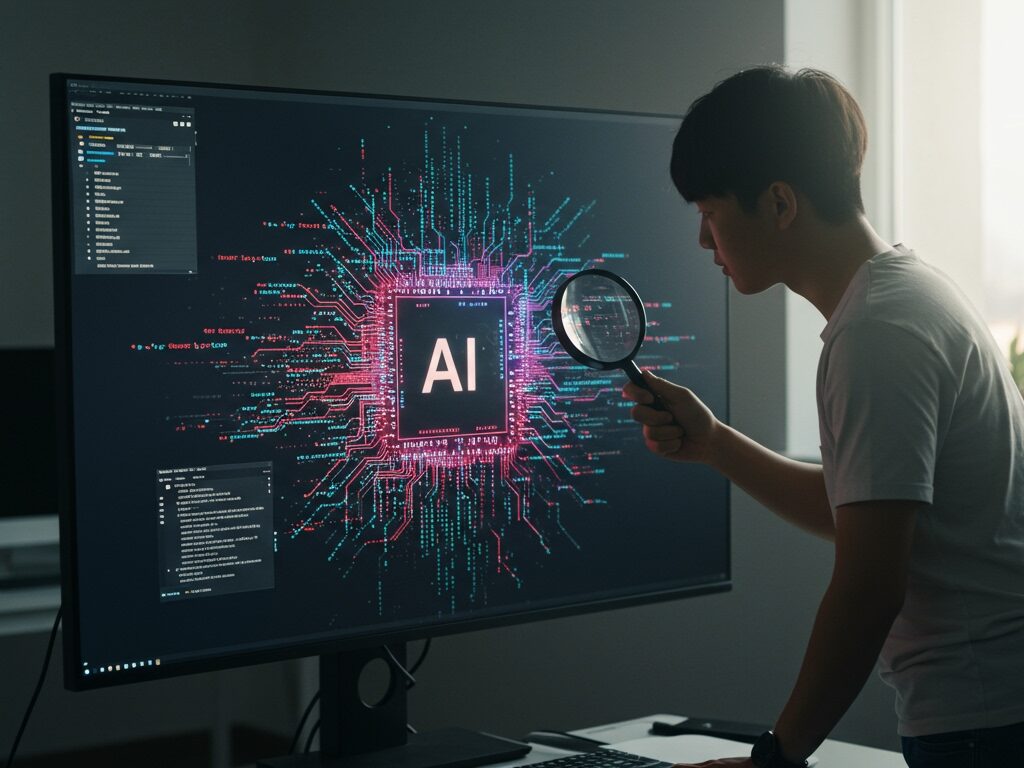
Communicating with AI effectively requires a shift in mindset. It’s less about talking to a machine and more about guiding a creative collaborator. Here are the foundational principles:
Clarity and Specificity: The Foundation
Vague prompts lead to vague outputs. Be as precise as possible. Instead of “a cool landscape,” try “a vibrant, fantastical landscape at sunset, with bioluminescent flora and a towering, spiral mountain in the distance, cinematic lighting, ultra-detailed.”
- Use descriptive adjectives: “old,” “futuristic,” “melancholic.”
- Specify nouns: “oak tree,” “electric guitar,” “porcelain doll.”
- Define actions: “running,” “whispering,” “exploding.”
Context and Constraints: Guiding the AI
Provide the AI with necessary context. Tell it the style, mood, or purpose of the output. For example, for an image, specify “in the style of Van Gogh” or “a minimalist design.” For text, indicate “write a short story,” “generate five headlines,” or “in the tone of a professional journalist.”
Constraints are equally important. You can tell the AI what to exclude or limit. “Generate a character profile, but exclude any magical abilities.” This helps narrow down the possibilities and refine the output.
Iterative Refinement: The Power of Trial and Error
Rarely will your first prompt yield perfection. Prompt engineering is an iterative process. Generate an output, evaluate it, and then refine your prompt based on what worked and what didn’t. This feedback loop is essential for continuous improvement.
Think of it as sculpting. You start with a general shape, then chip away details, adding and subtracting until your vision emerges.
Understanding AI “Personalities” and Limitations
Different AI models excel at different tasks. Some are better at generating images, others at text. Even within text models, some are more creative, while others are better at factual summarization. Experiment with various tools to find what suits your creative needs. Also, be aware of their limitations. AIs may struggle with complex reasoning, abstract concepts, or maintaining long-form narrative consistency.
Practical Prompting Techniques for Creative Domains
Visual Arts: Crafting Imagery with Words
For text-to-image models (like Midjourney, DALL-E, Stable Diffusion), your prompts become a visual script. Describe every element you want to see, and importantly, how you want it to look.
- Subject: “A lone astronaut,” “a whimsical cottage.”
- Environment: “on a misty mountain,” “in a bustling cyberpunk city.”
- Style/Medium: “oil painting,” “digital art,” “photorealistic,” “concept art,” “watercolor.”
- Lighting/Mood: “dramatic volumetric lighting,” “soft morning glow,” “eerie, mysterious atmosphere.”
- Composition/Angle: “wide shot,” “close up,” “from a low angle.”
Example: 'A majestic dragon soaring above a medieval castle, golden hour, epic fantasy art, highly detailed, by Frank Frazetta, 8K resolution.'
Written Content: Generating Ideas and Narratives
AI can be a powerful brainstorming partner for writers.
- Brainstorming: “Give me five plot twists for a sci-fi mystery about a lost colony.”
- Character Development: “Describe a rogue space pirate with a tragic past, including their appearance and a unique habit.”
- Content Generation: “Write an introductory paragraph for a blog post about sustainable fashion, with an optimistic tone.”
- Summarization: “Summarize this article on quantum physics into bullet points for a general audience.”
Example: 'Generate three distinct taglines for a luxury eco-tourism brand targeting adventurous young professionals, emphasizing sustainability and unique experiences.'
Design & Concepts: Shaping Digital Blueprints
Designers can use AI for rapid prototyping, logo ideas, or UI/UX mockups.
- Logo Concepts: “Design a minimalist logo for a coffee shop called ‘The Daily Grind,’ incorporating a coffee bean and a book, modern aesthetic.”
- UI/UX Ideas: “Propose three different user interface layouts for a mobile fitness tracking app, focusing on ease of use and visual appeal.”
- Product Design: “Create a concept image for a futuristic, ergonomic computer mouse made from recycled materials, sleek design.”
Example: 'Imagine a minimalist, modern living room interior design concept, with natural light, indoor plants, and a comfortable reading nook.'
Beyond Basic Prompts: Negative Prompts, Styles, and Modifiers
Advanced techniques allow for even greater control:
- Negative Prompts: Tell the AI what you don’t want. For image generation,
'--no text, blurry, distorted'can prevent unwanted elements. - Styles and Artists: Specify artistic styles (e.g., “Art Nouveau,” “Cubist”) or famous artists (e.g., “by Vincent van Gogh,” “inspired by Hayao Miyazaki”).
- Modifiers: Add details like “8K,” “photorealistic,” “cinematic,” “highly detailed,” “unreal engine,” for higher fidelity outputs.
- Weighting (platform-dependent): Some platforms allow you to assign importance to parts of your prompt (e.g.,
'red::2 car::1'makes “red” twice as important as “car”).
No-Code Tools for Creative AI Workflows
The beauty of modern AI tools is their user-friendliness. You don’t need to touch a single line of code to use them effectively.
Popular AI Platforms
- DALL-E 3 (OpenAI): Excellent for image generation, particularly good at understanding complex descriptive prompts. Integrates well with ChatGPT Plus.
- Midjourney: Renowned for its artistic, high-quality image generation, often favored by concept artists and illustrators. Accessible via Discord.
- Stable Diffusion (Stability AI): An open-source option that can be run locally or used through various online interfaces, offering high customization.
- ChatGPT (OpenAI): Versatile for text generation, brainstorming, coding assistance, and more.
- Claude (Anthropic): Strong competitor to ChatGPT, known for its conversational abilities and longer context windows.
- Google Gemini: A powerful multimodal AI capable of understanding and generating various content formats.
Integrating AI into Your Creative Process
Consider AI as another tool in your creative toolkit, similar to Photoshop or a word processor. You can use it at various stages:
- Brainstorming Phase: Rapidly generate ideas for themes, characters, or compositions.
- Drafting/Sketching: Create preliminary versions of text or images to get a feel for the direction.
- Refinement: Use AI to iterate on specific elements or explore variations.
- Inspiration: Combat creative blocks by asking AI for unexpected ideas.
Ethical AI & Responsible Prompting
As creative professionals, using AI comes with responsibilities. Awareness of ethical considerations is paramount.
Acknowledging Bias and Limitations
AI models are trained on vast datasets, which can reflect existing biases in society. Outputs might perpetuate stereotypes or generate inaccurate information. Always critically evaluate AI-generated content. Fact-check text, and ensure images align with your values and diverse representation.
Copyright and Attribution in the AI Era
The legal landscape around AI-generated content is still evolving. Research the terms of service for each AI tool you use regarding commercial use and ownership. When incorporating AI elements into your work, consider disclosing their use, especially if it’s a significant portion of the final output. Respect original artists and intellectual property.
Common Prompting Pitfalls to Avoid
Even with the best intentions, prompts can go wrong. Here are frequent mistakes:
- Vague Instructions: “Make a picture.” This will lead to unpredictable, often unusable results. Be specific!
- Expecting Perfection on the First Try: AI is not a mind-reader. It requires guidance and refinement.
- Ignoring Iteration: Don’t generate one prompt and move on if it’s not perfect. Tweak, adjust, and re-run.
- Over-Promoting: Sometimes, too many instructions can confuse the AI. Find a balance between detail and conciseness.
- Not Experimenting: Sticking to the same prompt structures limits your potential. Try new keywords, new orderings, and new techniques.
The Future of Creativity with AI
AI is not here to replace human creativity, but to augment it. As prompt engineering evolves, it will become an even more intuitive dialogue between human intention and artificial intelligence. Creative professionals who embrace these tools and master the art of AI communication will find themselves at the forefront of a new artistic revolution, pushing boundaries and bringing imaginative ideas to life faster and more innovatively than ever before.
Conclusion
Prompt engineering is the gateway for non-coders to harness the incredible power of artificial intelligence. By understanding the principles of clear communication, specificity, and iterative refinement, creative professionals can transform their workflows, generate stunning outputs, and unlock new dimensions of their artistic expression. Start experimenting today, and discover how AI can become your most versatile creative partner.
FAQ
Q1: Do I need to learn to code to use AI tools for creative work?
No, absolutely not. Most modern generative AI tools are designed with user-friendly interfaces that require no coding knowledge. Your primary skill will be crafting effective natural language prompts.
Q2: What’s the most important tip for a beginner in prompt engineering?
Start with specificity. Instead of broad terms, use descriptive adjectives, clear nouns, and precise instructions. The more detailed your prompt, the closer the AI will get to your vision.
Q3: Can AI steal my creative style or ideas?
AI models learn from vast datasets, but they don’t ‘steal’ in the human sense. They generate new content based on patterns they’ve observed. However, always check the terms of service of the AI tool you use regarding intellectual property and commercial use. Ethical considerations are important.
Q4: How do I choose the best AI tool for my creative project?
It depends on your project. For highly artistic images, Midjourney or Stable Diffusion might be great. For text generation and brainstorming, ChatGPT or Claude are excellent. Experiment with different tools to see which best fits your specific needs and aesthetic preferences.
Q5: Is AI going to replace creative jobs?
AI is more likely to transform creative jobs rather than replace them entirely. Professionals who learn to effectively use AI as a tool will gain a significant advantage, automating repetitive tasks and focusing on higher-level conceptual and strategic work that requires human intuition and empathy.
